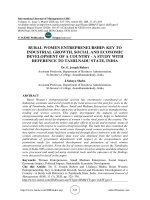Economic growth and economic development 58
Bạn đang xem bản rút gọn của tài liệu. Xem và tải ngay bản đầy đủ của tài liệu tại đây (109.66 KB, 1 trang )
Introduction to Modern Economic Growth
2.1.2. Market Structure, Endowments and Market Clearing. For most
of the book, we will assume that all factor markets are competitive. This is yet
another assumption that is not totally innocuous. Both labor markets and capital
markets have imperfections that have important implications for economic growth.
But it is only by starting out with the competitive benchmark that we can best
appreciate the implications of these imperfections for economic growth. Furthermore, until we come to models of endogenous technological change, we will assume
that product markets are also competitive, so ours will be a prototypical competitive
general equilibrium model.
As in standard competitive general equilibrium models, the next step is to specify
endowments, that is, what the economy starts with in terms of labor and capital
and who owns these endowments. Let us imagine that all factors of production are
owned by households. In particular, households own all of the labor, which they
supply inelastically. Inelastic supply means that there is some endowment of labor
¯ (t), and all of this will be
in the economy, for example equal to the population, L
supplied regardless of the price (as long as it is nonnegative). The labor market
clearing condition can then be expressed as:
(2.3)
¯ (t)
L (t) = L
for all t, where L (t) denotes the demand for labor (and also the level of employment).
More generally, this equation should be written in complementary slackness form.
In particular, let the wage rate (or the rental price of labor) at time t be w (t),
¯ (t), w (t) ≥ 0
then the labor market clearing condition takes the form L (t) ≤ L
¡
¢
¯ (t) w (t) = 0. The complementary slackness formulation makes sure
and L (t) − L
that labor market clearing does not happen at a negative wage–or that if labor
¯ (t) at zero wage.
demand happens to be low enough, employment could be below L
However, this will not be an issue in most of the models studied in this book (in
particular, Assumption 1 and competitive labor markets make sure that wages have
to be strictly positive), thus we will use the simpler condition (2.3) throughout.
The households also own the capital stock of the economy and rent it to firms.
We denote the rental price of capital at time t be R (t). The capital market clearing
condition is similar to (2.3) and requires the demand for capital by firms to be equal
44









